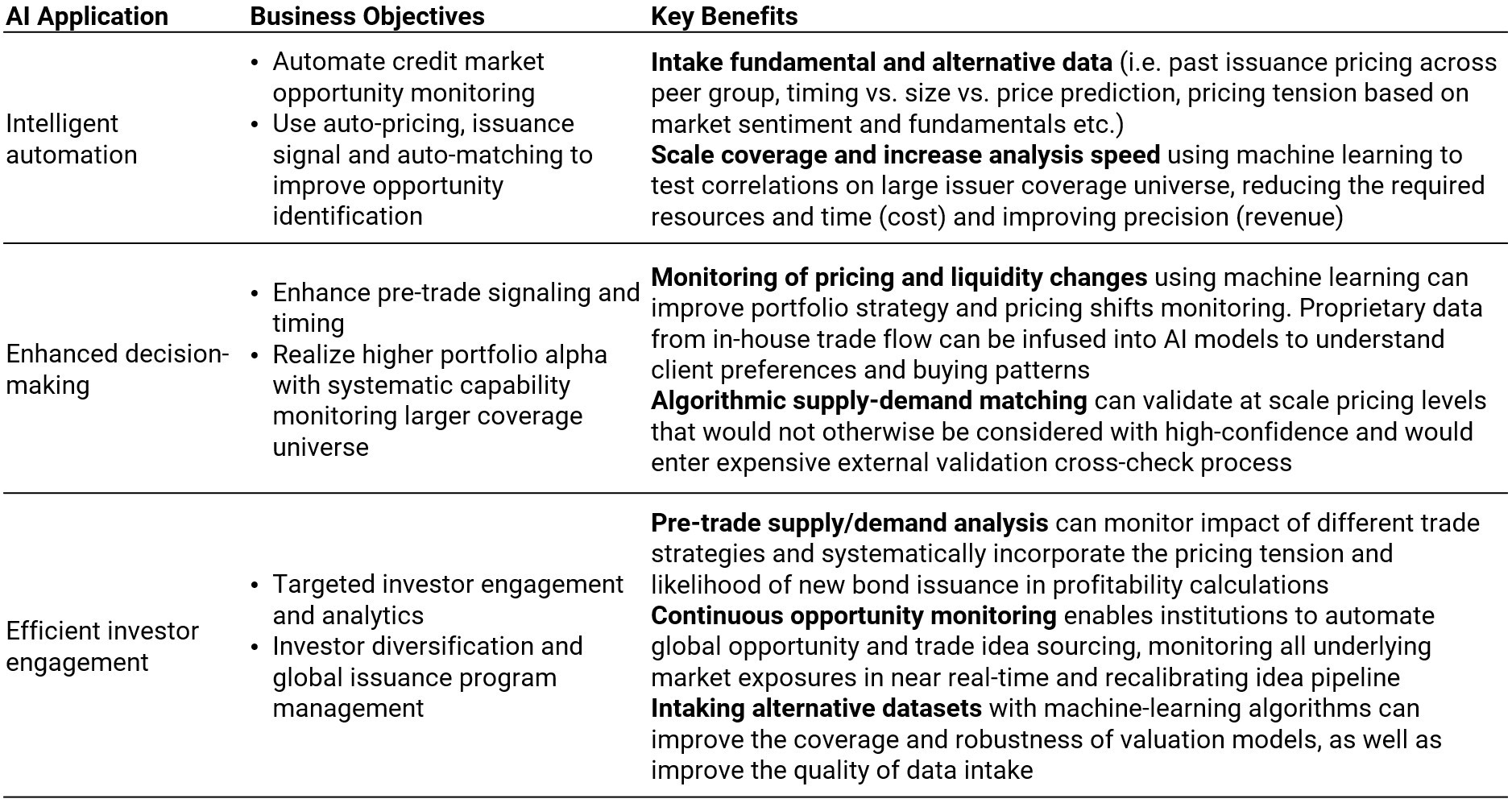
Over the past two years, we have witnessed profound changes in the fixed income marketplace with counterparties increasingly adopting quantitative investing and liquidity risk monitoring techniques. These include adoption of new methods of analysis such as AI analytics like COBI-Matching algorithm.
Source: Overbond

Fixed Income Artificial Intelligence
The financial services market is embracing digital processes and artificial intelligence applications to streamline business workflow. New bond distribution and OTC trading are one of the few areas which have a great need to embrace the trend. The current fixed income capital market data flows are inefficient in many respects, limiting precision in assigning proper value to credit risk long term and identification of traditional and non-traditional bond buyers. Markets remain heavily reliant on segregated and manual data operations between counterparties and as a consequence, disparate data sets. These disparate data sets cause the market to suffer from information asymmetry and decentralization. As a result, insight from available data is fragmented and disseminated through manual exchanges between counterparties, which furthers creation of disparate data sets.
Need for centralization of information
There is a great need for a fixed income big-data centralization where advanced analytics such as price discovery, buyer risk appetite and matching, intelligence gathering, pre-trade and post-trade analytics can be performed – to increase the overall efficiency of the fixed income market and understanding of the credit risk valuations that meet market demand. With no centralized hub, issuers and investors operate with partial awareness. AI application utilizing deep historical data records of fundamental data elements (audited statements, dealer supplied primary bond price quotations etc.) and secondary market bond trade points can solve this problem. With this, Overbond pioneered to be the first to market with a centralized big-data hub powered with AI capabilities for fixed income analytics.
Overbond AI Focus Areas:
Market Opportunity Discovery – Algorithmic matching of target buyers with fixed income opportunities, based on past buying patterns, portfolio manager preferences, rebalancing events and preferred industry sector, rating or tenor. Profiling traditional and non-traditional investors for each fixed income market opportunity.
Predictive Issuance Analytics – Proprietary machine learning algorithms systematically identify highly likely new bond issuances, providing institutional investors with exclusive pre-trade insights into the fixed income market new-supply unreached by prior analytical methods.
Tailored Portfolio Optimization – Market-optimized allocations data on investor holdings along with sophisticated bond pricing and issuance algorithms, output customized trade ideas, generating alpha for bond pricing trends and new-supply, as well as systemic audit-trail and liquidity risk management.
Custom AI Solutions

How COBI-Matching Algorithm Works
COBI-Matching is an advanced AI algorithm family which makes ongoing observations of investor behavior, buying-patterns and rebalancing events. COBI-Matching identifies a set of traditional and non-traditional buyers for each market credit opportunity. It analyzes features focusing on data variables below.
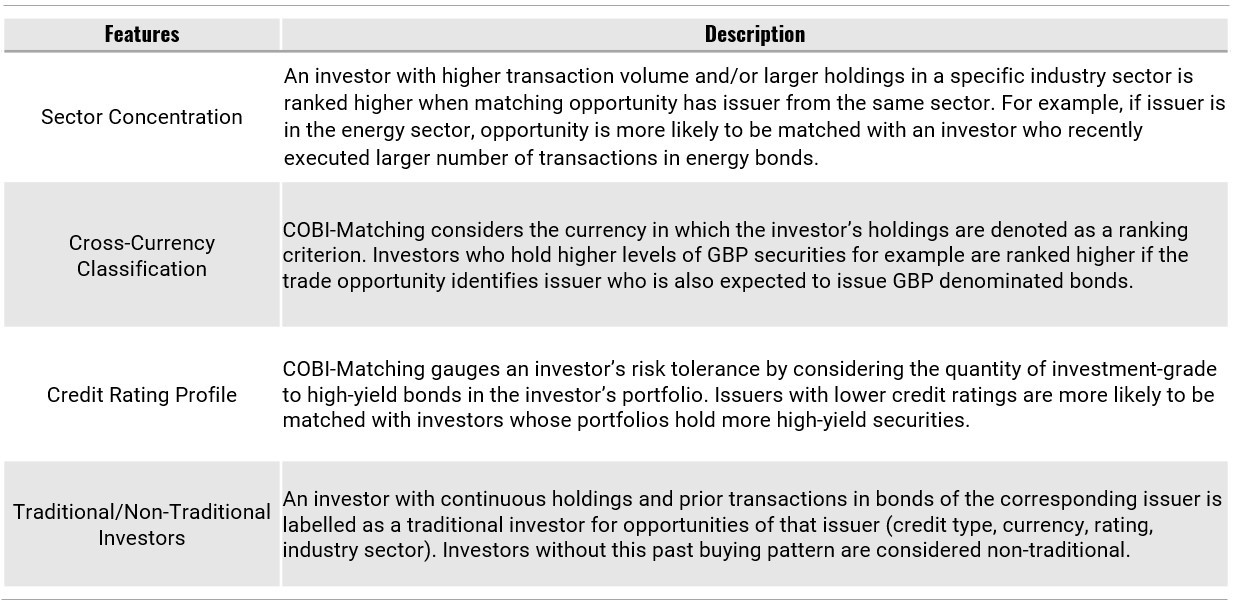

AI advantage over statistical methods
COBI-Matching AI modeling techniques share many similarities with classical statistical modeling techniques starting from the fact that they both deal with data. However, the key difference, between statistical techniques and AI models Overbond applies is in the goal of these approaches. While statisticians start with a set of known assumptions that are given to the model and best explain the expected behavior of the financial outcome in consideration, AI techniques rather aim at finding by themselves the method (with underlying assumptions that are unknown) that best predicts the outcome in consideration. AI is needed in situations like this, where it would be nearly-impossible for statistical quant to hypothesise and test 20+ years of market data from various data families.

How COBI-Matching Algorithm Works (con’t)
The diagram below and the following paragraphs provide a description of how the Overbond COBI-Matching algorithm works.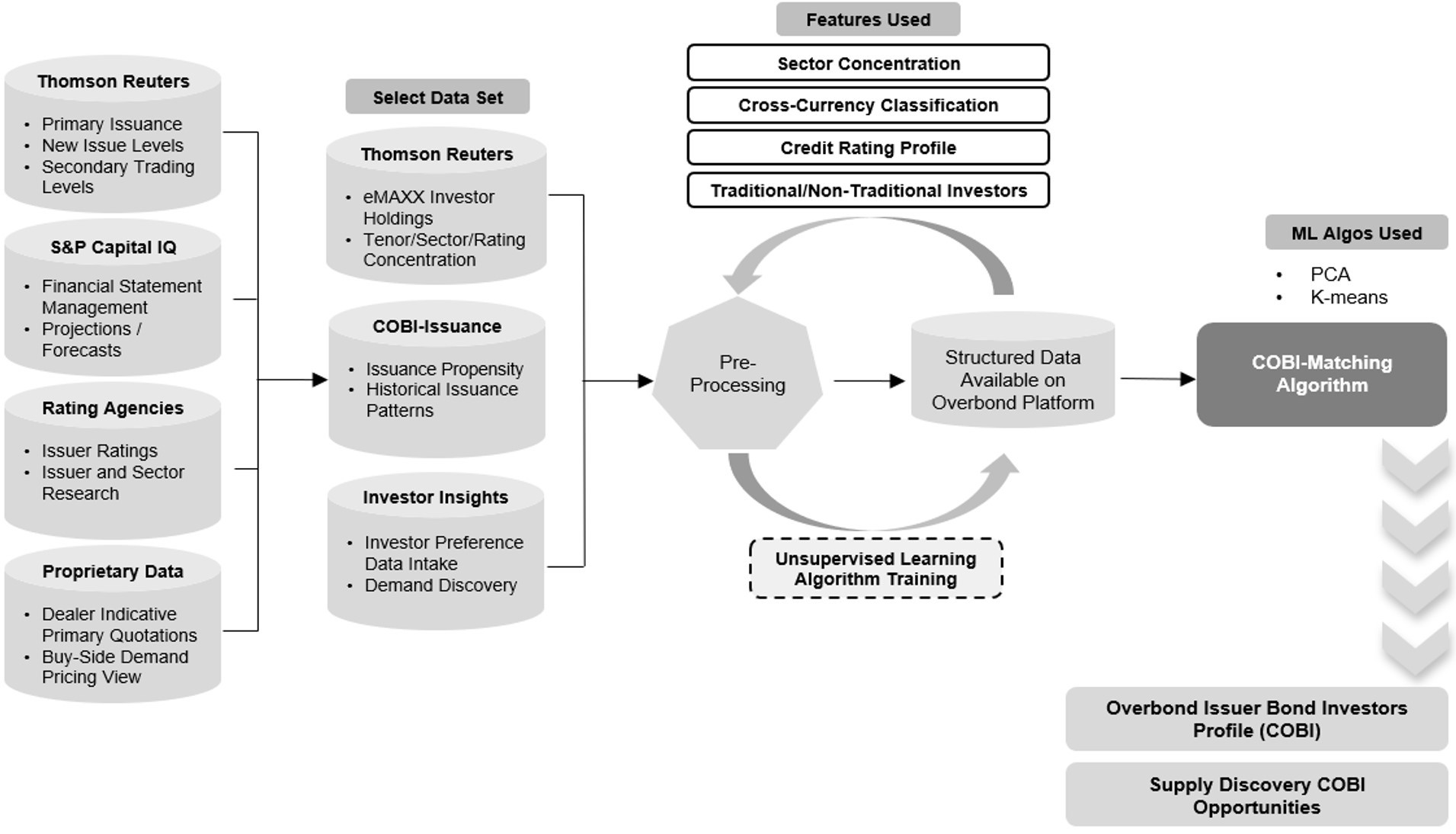
Data Intake & Pre-Processing
The Overbond platform sources raw trading and fundamental data via automated nightly scripts. This raw data is structured in the Overbond databases. Trading data and fundamental data are structured and mapped to the appropriate issuer ID. The data is systematically scrubbed for anomalies and null values. Finally, a set of key input factors are generated based on the raw input. These include but are not limited to factors that measure sector concentration, cross-currency classification of different investor types, credit rating profile investor preference and traditional /non-traditional investors.
COBI-Matching’s primary additive data input is eMAXX Investor holdings data sourced from Thomson Reuters. A data refresh is performed quarterly and algorithm monitors any changes in the investors’ holdings data table. eMAXX data bundles provide issuer/investor data, security classification, and credit rating data which are pre-processed before they are inputted into the algorithm.
Model Training
The subsequent stage for the machine learning algorithm is to train and apply several models to calculate the output investor relative match scores. An Ensemble Learning strategy is used, meaning multiple models are combined to elevate overall robustness. These models are each trained using a subset of the past data, ranging from one month to a maximum of ten years. Feedback loops for machine learning have been established through investor insights campaign that runs monthly and sources on average 4 billion USD in non-executable investor credit preferences (across corporate, sovereign, supra-sovereign, municipal and provincial issuer credit). Finally, the results are back-tested against the entire ten years of data history and measured for precision and recall metrics.

COBI-Matching Data Intake
The successful data intake and pre-processing are the key stages and pre-requisite for the COBI-Matching algorithm operation. The precision of the algorithm output is critically dependent on the accuracy, timeliness, and relevance of the pre-processed input data. Overbond sources raw data from major data suppliers in the financial sector, including Thomson Reuters, S&P Global Market Intelligence, major credit rating agencies, proprietary sources, as well as other sources. The data COBI-Matching algorithms use includes the following:
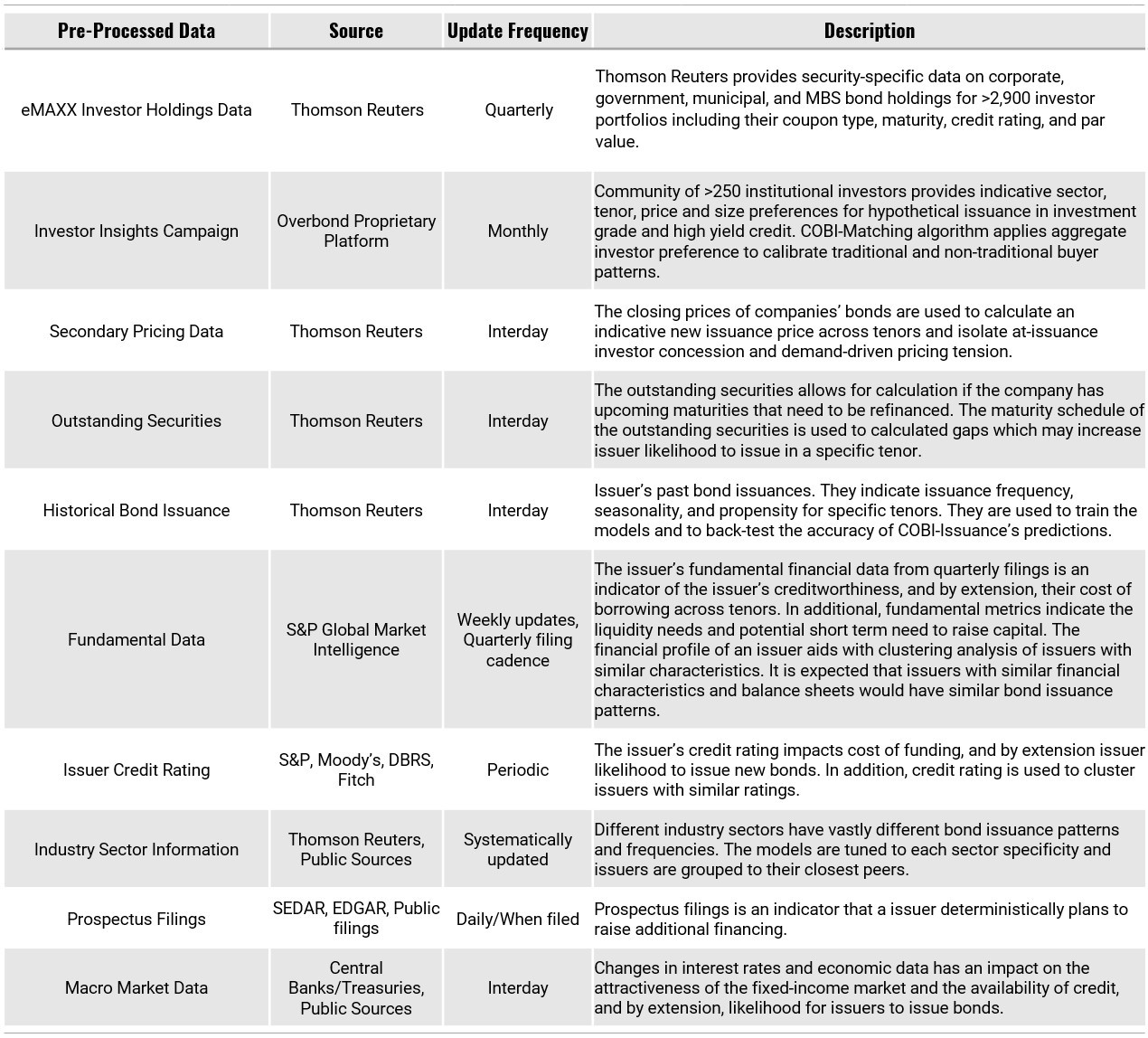

Use Cases for Issuers and Dealers
Bond Issuance Challenges
One of the important factors in establishing and running optimal borrowing program for bond issuers is that they can identify and engage investors that are willing to purchase a prospective issuance. Due to primary market fragmentation in information flow and distribution, it is harder to uncover non-traditional buyer preferences. COBI-Matching algorithm identifies extensive list of traditional and non-traditional investors for a potential issuer credit type or risk profile. At a macro level market-wide, COBI-Matching can source demand considering international cross-currency investor buying patterns, that currently could not be discovered efficiently, through manual analysis.
COBI-Matching’s Solution
COBI-Matching resolves these issues by providing a methodical way to identify investor demand and extensive list of all active global buyers. COBI-Matching begins by analyzing portfolio holdings and transaction history. Based on the results of the above analysis, the algorithms generate a list of traditional investors for each issuer as they currently hold exposure to that issuer name. As a next step, based on pre-defined criteria of issuance opportunity for matching (tenor, rating, currency, sector) COBI-Matching algorithms outputs a list of additional non-traditional buyers that hold inventory positions meeting the issuance pre-defined criteria but have not yet bought bonds of the particular issuer at hand.
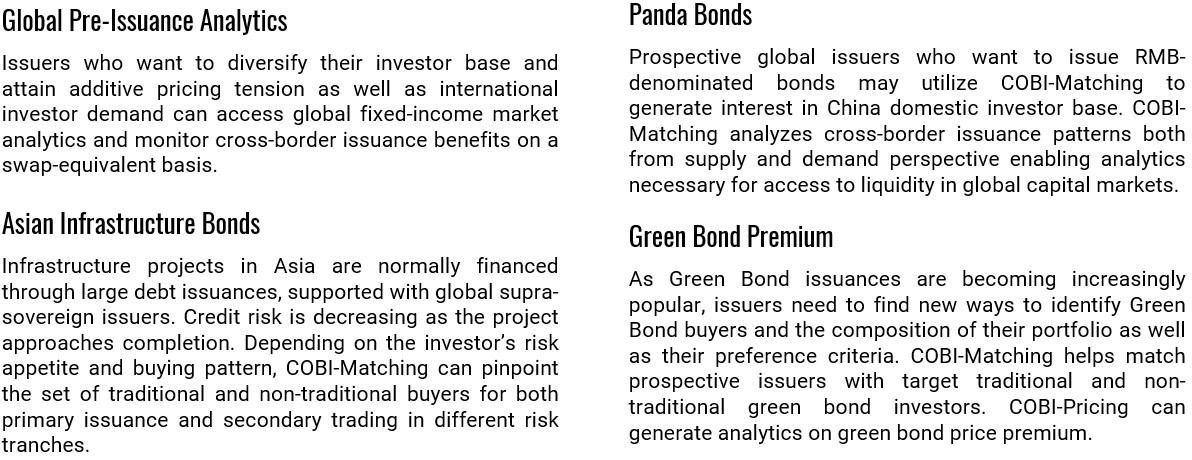

Ranking Mechanism
COBI-Matching ranks each investor depending on their likelihood of investing in a security with the predefined criteria. The ranking is based on the quantity the investor currently has invested based on the inputted criteria, number of prior transactions in relevant category, and notional size of purchasing activity. As an example, an investor with high amount of USD bonds in their portfolio will be ranked higher when the issuance opportunity is USD denominated. The investor rank (outputted as number of stars beside investor organization name) represents the quintile in which the investor ranks after COBI-Matching ranking algorithm finished the analysis (i.e. an investor in the upper quintile will show five stars while an investor in the lower quintile will show one star).
Investor Segregation and Ranking
Using issuer credit type characteristics, COBI-Matching first identifies investors who are traditional buyers. Once these investors are identified and ranked, algorithms identify non-traditional buyers based on currency, rating or industry sector buying preferences. Each prospective investor is ranked based on the contents of their portfolio, frequency of their buying patterns, expressed preferences and rebalancing.
Pre-Issuance Analytics Example
As a first test case, assume KfW, global supra-sovereign issuer was preparing for EUR bond issuance and wanted to gauge the interest for their prospective primary bond deal. Below are insights COBI-Matching can produce pre-deal launch for KfW prospective issuance.

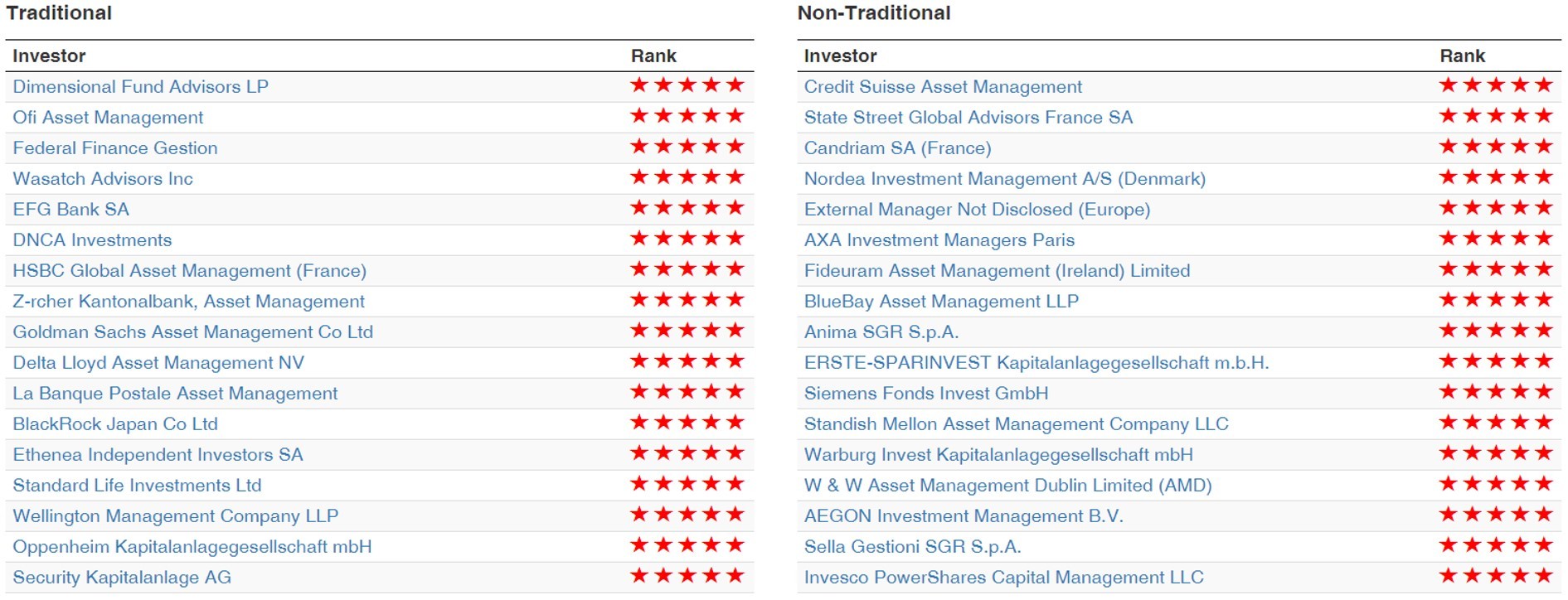
Whether KfW investor engagement strategy needed to look for a broad or more targeted investor universe, COBI-Matching algorithms are able to accurately identify investors that fit program objectives.
Ranking Mechanism (con’t)
In the second test case below, particular issuance opportunity for supra-sovereign credit of KfW was further refined with objective to identify non-traditional investors that have invested in the past in the financial industry sector, same rating and credit type, KfW peer group, but not in the KfW credit. Based on the algorithm buying pattern analysis, resulting output can pinpoint target investors adding additional criteria.
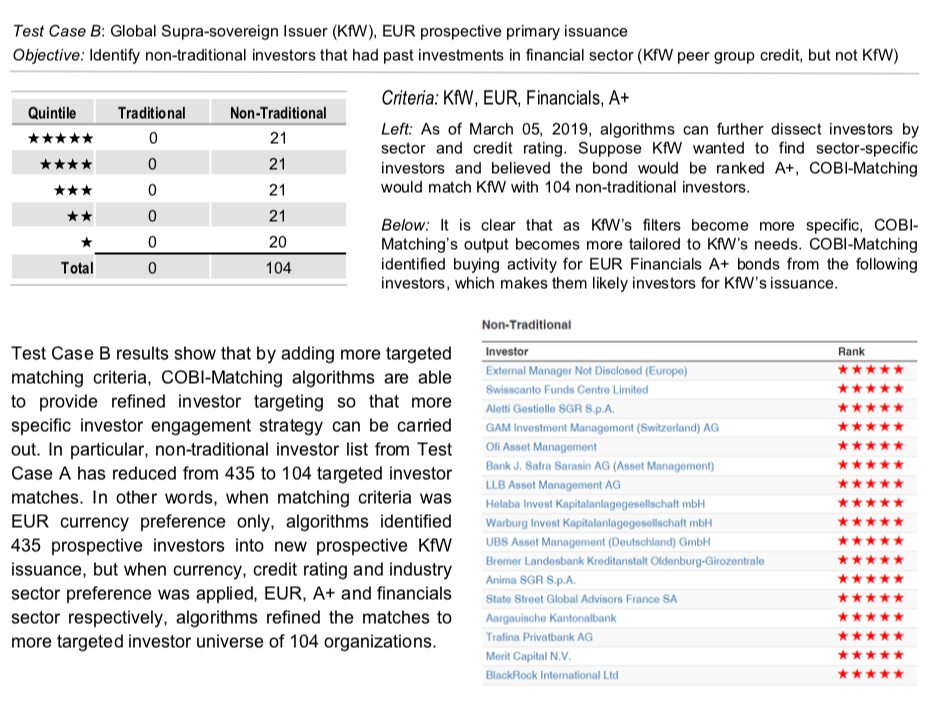
Whether KfW investor engagement strategy needed to look for a broad or more targeted investor universe, COBI-Matching algorithms are able to accurately identify investors that fit program objectives.

Investor Engagement
After list of traditional and non-traditional investors has been identified, Overbond platform has digital investor engagement software module that can seamlessly intake investor preferences and appetite per credit type, tenor, size or price. The visualization below shows sample result where 8 institutional investors submitted preferences for prospective hypothetical new bond deal of KfW, including their tenor, price and investment ticket size preferences.
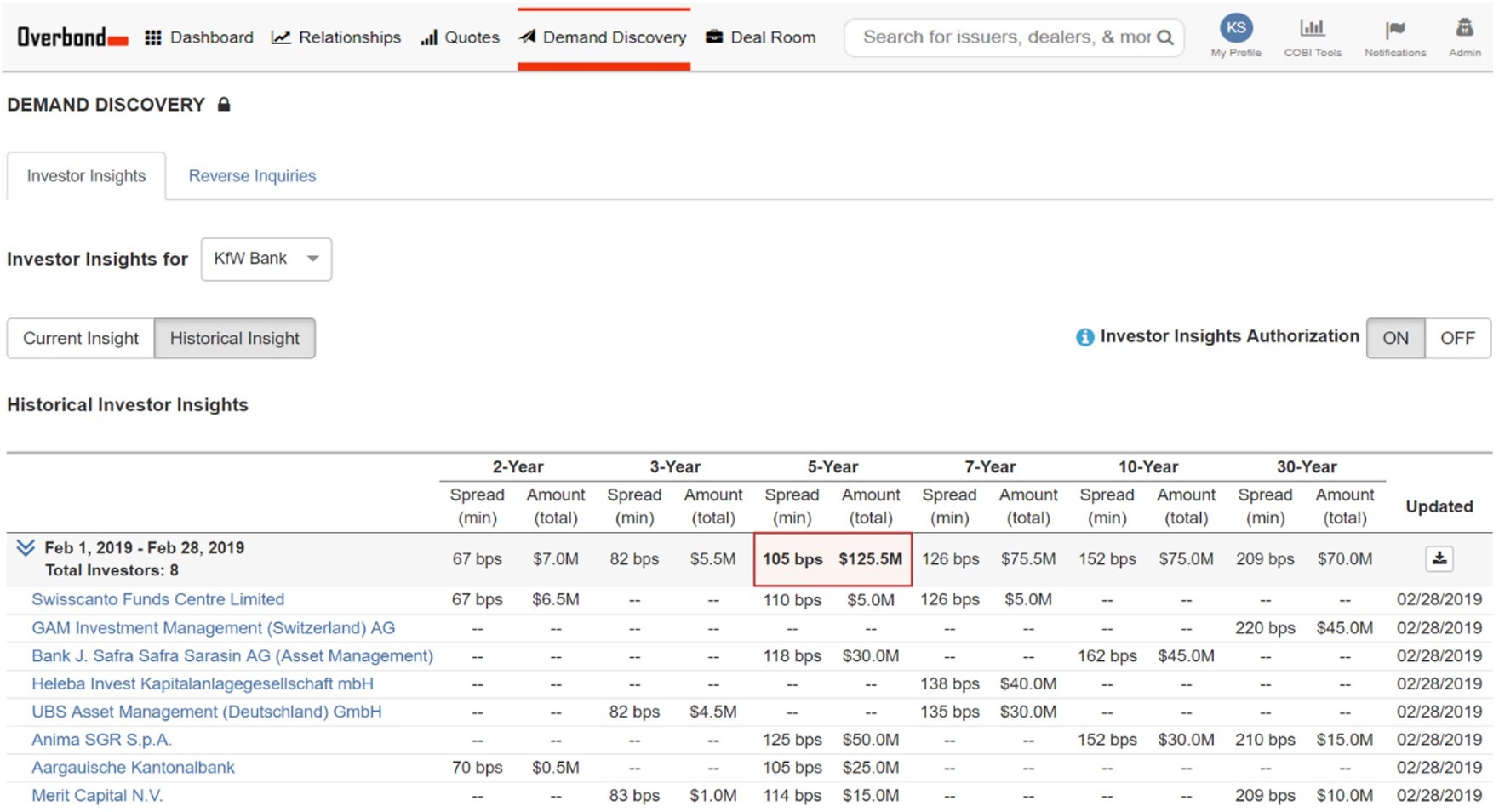
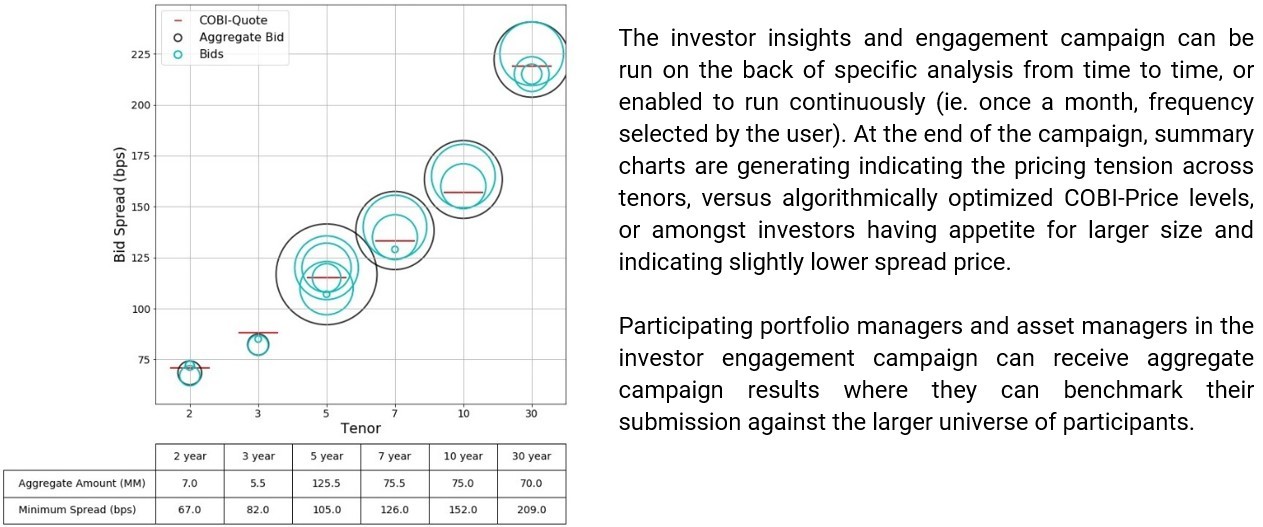

Use Cases for Investors
COBI-Matching can also be used as a powerful tool for investor portfolio managers and their teams when used in conjunction with COBI-Issuance algorithms output. COBI-Issuance generates a list of new bond deals most likely to happen in next 4-weeks (standard selected time horizon) along with their propensities to issue (measured signal strength). Selected new bond issuance opportunities from COBI-Issuance algorithms can then be inputted into COBI-Matching algorithms to identify their most likely investors. The outcome of this process is that identified investors can receive highly targeted trade ideas, systematically generated by algorithms monitoring pre-trade signals on entire global fixed income market. Trade ideas and pre-trade signals are generated prior to the issuer’s actual issuance, helping portfolio management and operating efficiency. Some of key use cases are below.

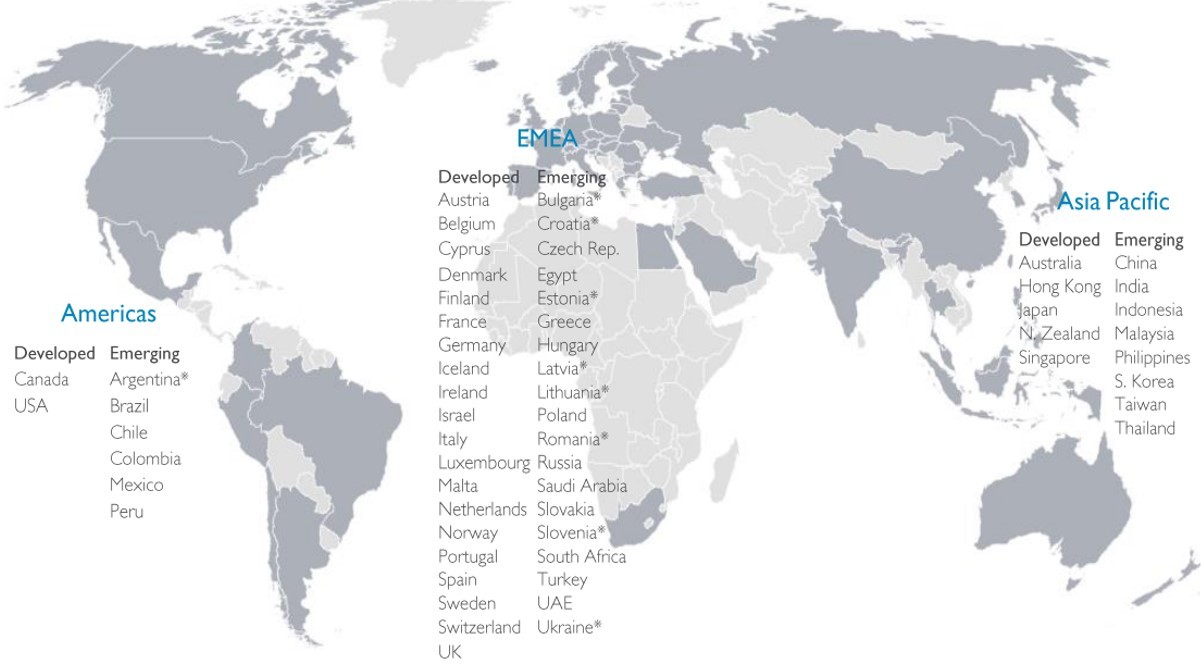

Use Cases for Investors (con’t)
The output of COBI-Matching for investors, trade ides and pre-trade signals are visualized as a match card. Match cards are provided in a standard format, which are generally structured as below.
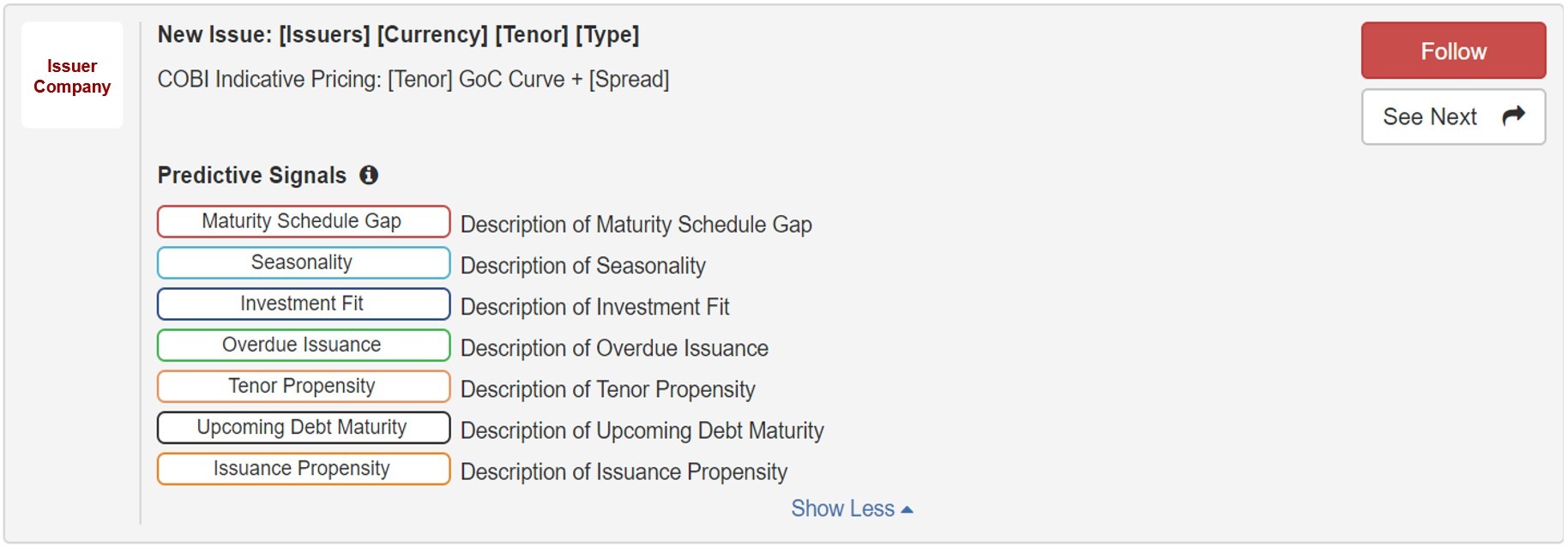
Using the structure above, below is a sample match card for a KfW 5-year issuance:
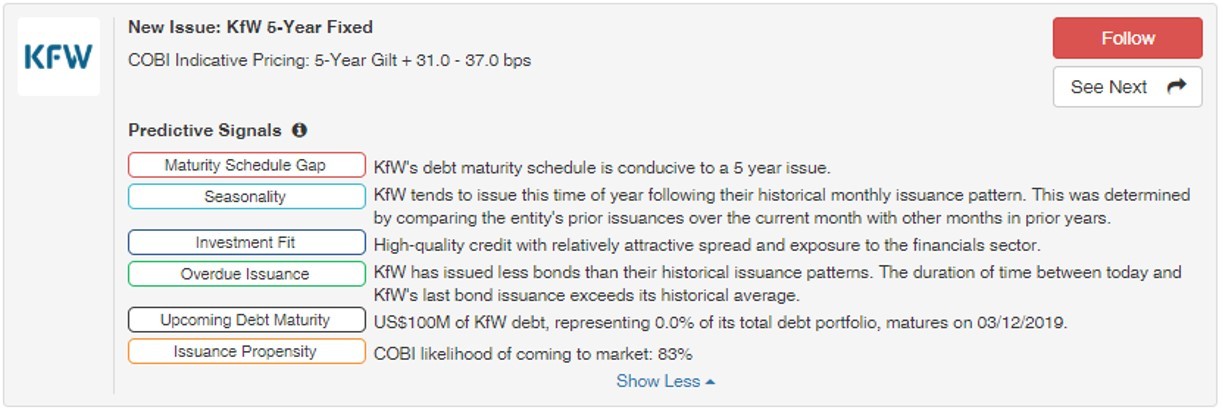
COBI-Matching analyzes investors’ current holdings as well as their historical buying patterns to determine the likelihood that the investor will invest in the profiled investment idea. In the above example, COBI-Matching would identify institutional investor with a recent holding or increase inholding of GBP investment-grade securities, in financial sector, and in KfW peer group. COBI-Matching algorithms can then make target new supply investment ideas available to investors meeting matching criteria, identified as target buyers. Since data on investor holdings is updated on a quarterly basis, COBI-Matching consistently outputs up-to-date investment recommendations that are relevant for target investors engaged.

Business Impact
Over the past two years, we have witnessed profound changes in the fixed income marketplace with counterparties increasingly adopting quantitative investing and market monitoring techniques. These include systematic alpha and algorithmic trading, liquidity risk management strategy, merging of fundamental discretionary and quantitative investment styles, consumption of increasing amounts of alternative data, and adoption of new methods of analysis such as AI analytics like COBI-Matching algorithm.

Implementation Considerations
Institutions considering AI predictive analytics implementation and big-data transformation projects, can employ acceleration utilizing externally calibrated models and market signals. Below are several key considerations and questions for executives in charge of AI roadmap:
-
- What is the current state of our fixed income in-house data?
- What are our data science and engineering capabilities?
- Are we building AI capabilities to grow revenue or cut cost?
- How can we redefine the boundaries of our data universe or identify alternative data sources necessary to feed AI engine?
- Given that AI learning curve is steep where do we begin?
- How do we create and execute AI proof of concept use cases rapidly?
- What are key success factors for our AI roadmap?
Custom AI Services
Overbond works with clients to identify and recommend practical AI analytics use cases that are aligned with strategic goals of the financial institution. We help assess current-state AI capabilities, and define roadmap to help clients realise value from AI applications. We manage cross-channel data flows across multiple systems and enable custom font-end visualizations.
Proven Methodology
With our targeted approach and implementation methodology, we quickly demonstrate value of AI analytics to test use cases, enabling client-side change management approach and stakeholder buy-in.
Operational Acceleration
We help clients build and deploy custom AI solutions to deliver proprietary analytics and tangible business outcomes. Our experience combines calibrated models, design patterns, engineering and data science best practices, that accelerate value and reduce implementation risk.
AI Analytics As-a-Service
Overbond helps customers design and oversee mechanisms to optimize and improve existing fixed income credit valuation, issuance and pricing prediction and pre-trade opportunity monitoring using AI. Our team of world-class data scientists and engineers manage an iterative implementation approach from current state assessment to operational handover.

About Overbond
Overbond specializes in custom AI analytics development for clients implementing risk management, portfolio modeling and quantitative finance applications. Overbond supports financial institutions in the AI model development, implementation and validation stages as well as ongoing maintenance.
Contact
Vuk Magdelinic
Chief Executive Officer
+1 416-559-7101
vuk.magdelinic@overbond.com


